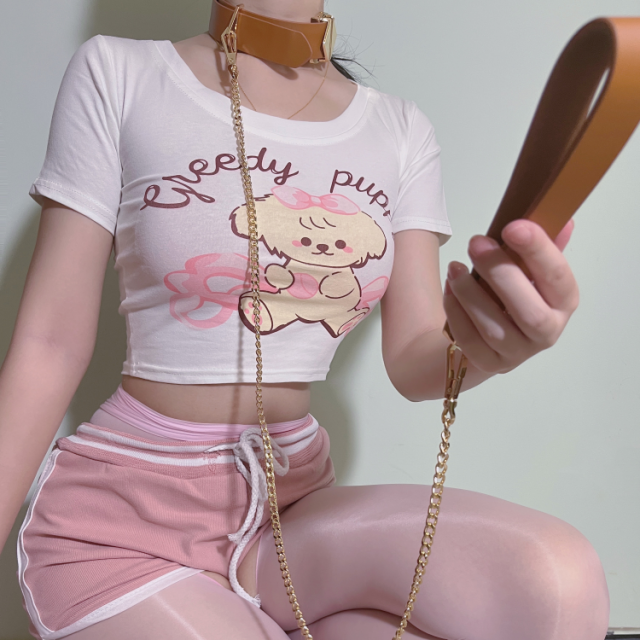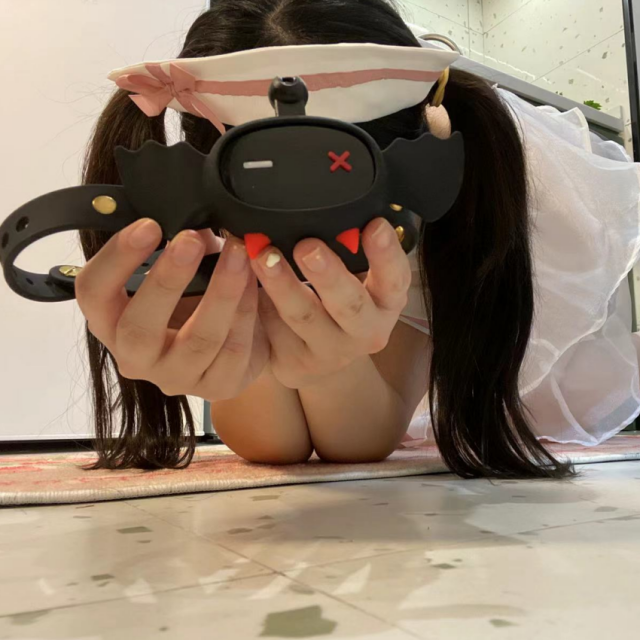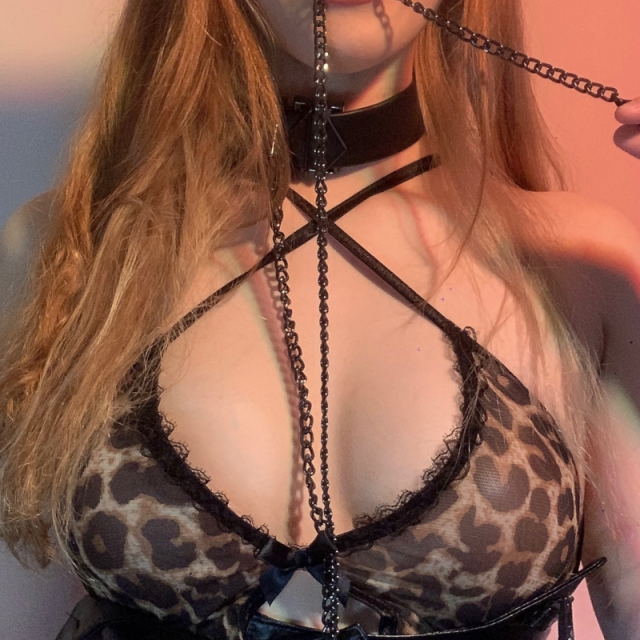By Jessica | 01 March 2024 | 0 Comments
What does a collar mean in BDSM?
In emotional relationships characterized by dominance and submission, many individuals choose to symbolically introduce collars as a special emblem. If you've ever been curious about the symbolic meaning of these collars or wish to incorporate this element into your own relationship, this guide provides the necessary information.

Wearing a collar symbolizes wholehearted dedication and commitment. It serves as a symbol of the emotional connection between the dominant and submissive partners. Permanent collars are often the most prevalent choice, signifying a commitment to constant or all-encompassing power exchange, with the submissive being referred to as a slave, belonging wholly to their master. However, not every collar holds such profound symbolic meaning.
Not necessarily. While collars are typically made of metal or leather, they can take various forms. Some couples prefer to use other items to express their relationship, such as necklaces, rings, bracelets, earrings, or watches. For a more masculine choice, belts and dog tags can also be suitable alternatives. With mainstream fashion gradually incorporating elements of kink/BDSM, many pieces of jewelry closely resemble collars used in dominant-submissive relationships. Heart-shaped locks can even be more discreet than actual padlocks. Of course, there's also the option of considering tattoos, though it's crucial to be aware of the potential risks of relationship endings and the permanence of tattoos.
However, sometimes, if you want to incorporate it into bondage activities, such as restraining with a belt or in other ways, only a real collar can meet these needs.

Usually in the form of jewelry (such as a necklace, collar, or bracelet), day collars allow the submissive to wear them in everyday environments or non-BDSM scenes. These day collars essentially enable you to discreetly showcase your D/S relationship without causing unnecessary attention.

Worn only during scenes, play collars are suitable for those who enjoy occasional BDSM games in otherwise regular relationships. Couples who do not feel the need to wear collars continuously, even in BDSM clubs or parties, may use play collars. Wearing a play collar is akin to putting on lingerie—it sets the mood for play and helps you enter a submissive headspace. Collars in this category are often more of a part of the costume than a symbol of D/S in pet play.

If you aspire to wear a collar as a submissive, your dominant partner may require you to earn it. For some, this process is more informal, involving spending time together, getting to know each other, and envisioning a future together. During this period, the submissive should be a good partner and display a submissive attitude. Becoming a good submissive often means committing to personal growth, not just engaging in kinky activities. Therefore, overcoming bad habits might be a way to earn the collar. Losing weight or exercising to become healthier are also paths to consider. Regardless of the approach, consistency is key, and the dominant may require a display of absolute submission after trust has been established.
Typically, the one in the dominant position gives the submissive a collar. Choosing or designing a collar can be a significant and serious task, akin to picking out wedding rings. For dominants, it's not uncommon to engrave special information, names, or dates on metal or leather collars. While collars may be expensive and require customization, their symbolic significance far outweighs the cost, similar to engagement or wedding rings.
Dominants might opt to surprise their submissives with a collar, but submissives are often aware of an impending collar and strive to prove themselves deserving of this special reward. If you prefer an intimate atmosphere or don't intend to wear a permanent collar, you can bestow the collar upon your partner when you're alone. You might want to create an atmosphere that represents your relationship, whether it's romantic, sexy, quirky, or in another way meaningful.

It depends on the situation. Some submissives or slaves may feel more liberated after wearing a collar because it provides protection and intimacy. On the other hand, dominants may feel more responsibility, as the collar signifies they must care for the submissive in both good times and bad, extending beyond mere aftercare.
However, if you've already reached a significant level of commitment, the collar may not change much in the relationship, similar to how marriage doesn't always alter everything. Nevertheless, it's still essential to be aware of and acknowledge any biases or preconceptions you may have regarding the collar, even if these biases only surface subconsciously after the event.
Some couples place significant importance on the symbolic meaning of collars and establish a set of rules for each time the collar is worn. These rules may involve language usage (using formal language), posture, eye contact (keeping it lowered), and may even extend to walking behind or in step with the dominant. Some dominants may require their submissives to remain within their line of sight or expect them to do so for their protection.
More specific expectations may include obeying requests and commands, accepting discipline, and always being sexually prepared, whether for oral sex or other forms of sexual activity.
As mentioned earlier, removing the permanent collar may signify the end of the relationship. However, dominants may also choose to remove the collar as a form of punishment, requiring the submissive to win it back through specific actions or tasks. The decision to remove the collar should be explicit and may be reflected in prior agreements or a slave contract. The collar should not be casually discarded. Some people even playfully refer to easily removable collars as "Velcro" collars. However, when a submissive crosses boundaries, the dominant has the ultimate decision-making power. When the collar is removed, the submissive often experiences strong emotions, such as sadness, loss, panic, or anger, even if it's for practical reasons like cleanliness.

If you're considering changing the collar, careful consideration of the aspects of the relationship that need improvement is essential. Dominants may assign tasks to submissives to win back the collar, or both partners may need to focus on communication to confirm that the dynamics of D/s and the commitment are what they desire. Positive kink therapy may also be appropriate in certain situations.
Because removing the collar is a significant offense for the submissive, it's crucial to be absolutely certain of your desire for this level of commitment before agreeing to become a collar substitute. If you don't understand what replacing a collar entails or the responsibilities involved, you shouldn't propose such an action.
Finally, while the symbolic meaning of the collar is apparent, it's worth emphasizing that any BDSM or sexual activity (including BDSM contracts) requires mutual consent. While most submissives may feel honored and excited to receive a collar, it's essential not to force them to wear one if their viewpoints differ.
More articles of interest to you:
beneficial effects of bdsm
why we need aftercare?
tips for permanent chastity
What Does it Symbolize in the D/s (Dominance and Submission) Realm?

Wearing a collar symbolizes wholehearted dedication and commitment. It serves as a symbol of the emotional connection between the dominant and submissive partners. Permanent collars are often the most prevalent choice, signifying a commitment to constant or all-encompassing power exchange, with the submissive being referred to as a slave, belonging wholly to their master. However, not every collar holds such profound symbolic meaning.
Does the Collar Have to be a Traditional One?
Not necessarily. While collars are typically made of metal or leather, they can take various forms. Some couples prefer to use other items to express their relationship, such as necklaces, rings, bracelets, earrings, or watches. For a more masculine choice, belts and dog tags can also be suitable alternatives. With mainstream fashion gradually incorporating elements of kink/BDSM, many pieces of jewelry closely resemble collars used in dominant-submissive relationships. Heart-shaped locks can even be more discreet than actual padlocks. Of course, there's also the option of considering tattoos, though it's crucial to be aware of the potential risks of relationship endings and the permanence of tattoos.
However, sometimes, if you want to incorporate it into bondage activities, such as restraining with a belt or in other ways, only a real collar can meet these needs.
Types of BDSM Collars:
Consideration Collar:
Although relatively uncommon, some people use consideration collars to signify that they are contemplating establishing a special relationship with a submissive. These collars provide some protection, are easy to remove, and are not permanent. Some individuals may transition directly to permanent collars, while others may choose to add a training collar after this stage.Training Collar:
This type of collar indicates that the submissive is undergoing training, serving as an alternative to wearing a permanent collar. If training progresses smoothly, a collar ceremony and a full collar may follow.Permanent Collar:
These collars represent the highest level of commitment, expressing a pledge between submission and dominance, sometimes equivalent to marriage. Some individuals choose to wear them 24/7, even using locks held only by the dominant as a means of securing them. In these cases, removing the collar equates to ending the relationship. However, not everyone opts for continuous wearing.Day Collar:

Usually in the form of jewelry (such as a necklace, collar, or bracelet), day collars allow the submissive to wear them in everyday environments or non-BDSM scenes. These day collars essentially enable you to discreetly showcase your D/S relationship without causing unnecessary attention.
Play Collar:

Worn only during scenes, play collars are suitable for those who enjoy occasional BDSM games in otherwise regular relationships. Couples who do not feel the need to wear collars continuously, even in BDSM clubs or parties, may use play collars. Wearing a play collar is akin to putting on lingerie—it sets the mood for play and helps you enter a submissive headspace. Collars in this category are often more of a part of the costume than a symbol of D/S in pet play.
Protection Collar:
Temporary in nature, protection collars aim to prevent dominants from bothering submissives who have not yet adopted permanent collars. However, this is more than just wearing a fake wedding ring. Dominants providing protection to submissives wearing protection collars have a certain responsibility.Digital Collar:
While most people typically envision some physical collar, this practice has been adopted in online usage. In forums, chat rooms, and other BDSM spaces, submissives sometimes tag themselves as collared. This is often a symbol of a long-term relationship and may mean that other dominants cannot interact with them without permission from their dominant.Earning the Collar:

If you aspire to wear a collar as a submissive, your dominant partner may require you to earn it. For some, this process is more informal, involving spending time together, getting to know each other, and envisioning a future together. During this period, the submissive should be a good partner and display a submissive attitude. Becoming a good submissive often means committing to personal growth, not just engaging in kinky activities. Therefore, overcoming bad habits might be a way to earn the collar. Losing weight or exercising to become healthier are also paths to consider. Regardless of the approach, consistency is key, and the dominant may require a display of absolute submission after trust has been established.
Putting on the Sub Collar:
Typically, the one in the dominant position gives the submissive a collar. Choosing or designing a collar can be a significant and serious task, akin to picking out wedding rings. For dominants, it's not uncommon to engrave special information, names, or dates on metal or leather collars. While collars may be expensive and require customization, their symbolic significance far outweighs the cost, similar to engagement or wedding rings.
Dominants might opt to surprise their submissives with a collar, but submissives are often aware of an impending collar and strive to prove themselves deserving of this special reward. If you prefer an intimate atmosphere or don't intend to wear a permanent collar, you can bestow the collar upon your partner when you're alone. You might want to create an atmosphere that represents your relationship, whether it's romantic, sexy, quirky, or in another way meaningful.
Does Wearing the Collar Change the Relationship?

It depends on the situation. Some submissives or slaves may feel more liberated after wearing a collar because it provides protection and intimacy. On the other hand, dominants may feel more responsibility, as the collar signifies they must care for the submissive in both good times and bad, extending beyond mere aftercare.
However, if you've already reached a significant level of commitment, the collar may not change much in the relationship, similar to how marriage doesn't always alter everything. Nevertheless, it's still essential to be aware of and acknowledge any biases or preconceptions you may have regarding the collar, even if these biases only surface subconsciously after the event.
Collar Rules:
Some couples place significant importance on the symbolic meaning of collars and establish a set of rules for each time the collar is worn. These rules may involve language usage (using formal language), posture, eye contact (keeping it lowered), and may even extend to walking behind or in step with the dominant. Some dominants may require their submissives to remain within their line of sight or expect them to do so for their protection.
More specific expectations may include obeying requests and commands, accepting discipline, and always being sexually prepared, whether for oral sex or other forms of sexual activity.
Losing the Collar:
As mentioned earlier, removing the permanent collar may signify the end of the relationship. However, dominants may also choose to remove the collar as a form of punishment, requiring the submissive to win it back through specific actions or tasks. The decision to remove the collar should be explicit and may be reflected in prior agreements or a slave contract. The collar should not be casually discarded. Some people even playfully refer to easily removable collars as "Velcro" collars. However, when a submissive crosses boundaries, the dominant has the ultimate decision-making power. When the collar is removed, the submissive often experiences strong emotions, such as sadness, loss, panic, or anger, even if it's for practical reasons like cleanliness.

If you're considering changing the collar, careful consideration of the aspects of the relationship that need improvement is essential. Dominants may assign tasks to submissives to win back the collar, or both partners may need to focus on communication to confirm that the dynamics of D/s and the commitment are what they desire. Positive kink therapy may also be appropriate in certain situations.
Because removing the collar is a significant offense for the submissive, it's crucial to be absolutely certain of your desire for this level of commitment before agreeing to become a collar substitute. If you don't understand what replacing a collar entails or the responsibilities involved, you shouldn't propose such an action.
Finally, while the symbolic meaning of the collar is apparent, it's worth emphasizing that any BDSM or sexual activity (including BDSM contracts) requires mutual consent. While most submissives may feel honored and excited to receive a collar, it's essential not to force them to wear one if their viewpoints differ.
More articles of interest to you:
beneficial effects of bdsm
why we need aftercare?
tips for permanent chastity
Leave a Reply
Your email address will not be published.Required fields are marked. *